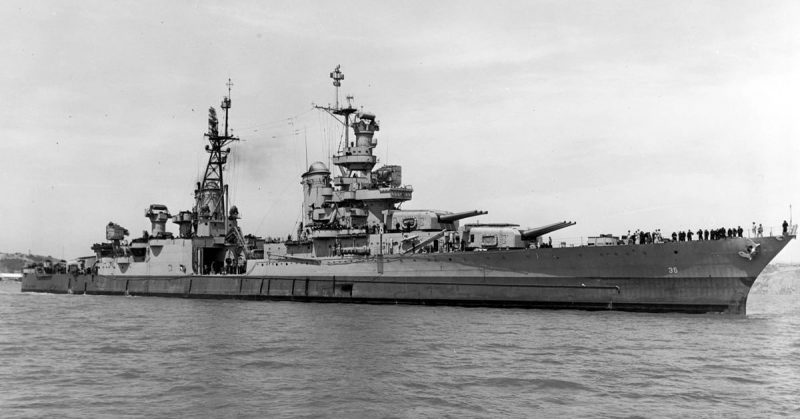Just after midnight on the 30th July 1945, Japanese torpedoes slammed into the hull of the USS Indianapolis and twelve minutes later this proud vessel with many of her crew were on their way to the bottom of the ocean. The Indianapolis had just left Tinian Island, where she delivered atomic bomb components, and as the secret part of her mission was completed she left Guam en route to Leyte, an island in the Philippines.
The men in the water were certain that the Navy would send help immediately. But the port officials in Leyte were not compelled to report that the Indianapolis had not arrived, so it was not until an anti-submarine aircraft reported finding survivors and oil on the water that any rescue mission was mounted.
The men in the water were in a living hell and in an interview with National Geographic, Edgar Harrell spoke of his harrowing ordeal, “At any given time you could look out and see big fins swimming around and around around. All of a sudden you heard a blood-curdling scream and you look and you see the shark had taken him under.”
Day after day went by. Skin began rotting, and Dick Thelen recalled seeing “a lot of guys just crack, or drink the water, or give up, or swim off to an imaginary island. It was survival mode. Pulling away from the group meant almost certain death. Those who pulled away were picked off by the sharks, or drank saltwater and they floated off.”
Lt. Adrian Marks, the pilot of the Catalina Flying Boat on the scene, told how he and his crew were faced with a heart-rending choice in trying to decide who to pick up. The decision they came to was to leave the men that were in groups, reasoning that they could collectively look after each other and scare away the sharks, and to rather concentrate on uplifting the individuals or those in pairs. They eventually collected 56 men.
The captain of the Indianapolis, Commander Charles Butler McVay III, was rescued on the 3rd August 1945, but his career in the Navy was finished as he was brought before a court-martial and found guilty of endangering his crew by not setting a zig-zag course. The captain of the Japanese submarine that sank the Indianapolis testified that this would not have helped but it did not sway the court-martial. Many of the crew who survived were angered with the verdict, and they felt that the commander had been made a scapegoat. In 2000, President Clinton signed a bill that exonerated McVay, but it was years too late as he had committed suicide in 1968.
To date, the wreck of the Indianapolis has not been found but recently a historian for the Naval History and Heritage Command, Richard Hulver, unearthed new information that could point to the wreck lying further west than previously surmised. It was a well-known fact that a cargo ship had passed the Indianapolis about twelve hours before it sank and using this knowledge and Google’s search engine he managed to track down a blog posting dated May 2015, written by the son of a sailor on that cargo ship. Having access to the necessary records, he managed to trace the father as Seaman 1st Class Francis G. Murdick and the cargo ship as the LST-779.
Using this information Hulver managed to trace the journey of the LST-779 and came to the conclusion that the vessel lay outside of the Navy’s initial search area. However, there are currently no plans to mount a new search as the Navy believes that the wreck lies in three miles of water on the edge of an underwater mountain range, making the use of sonar almost impossible.
The sinking of this vessel resulted in major loss of life, but it also resulted in changes being made to how ships are reported in and out of the harbour. The quality of life-saving equipment for the Navy was improved, and now no vessel carrying more than 500 personnel may sail alone.
Nicholas Cage will be starring in a movie about this event, and he will play Commander McVay. The film will support the 75th anniversary of the incident and will reflect on the heroism of the sailors and how they supported each other through a horrendous ordeal.
